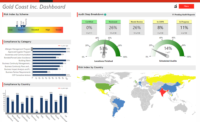Supply chains are threatened every day for a variety of reasons—power outages, train derailment, road closures, contamination in a supplier facility, terrorism, cyber-attacks, sabotage or industrial espionage, labor unrest, global pandemic, fires, floods and natural disasters, refrigeration equipment in need of repair, and more. These incidents are not a work of science fiction, and can negatively affect the supply chain.
Sometimes there are advance warnings; sometimes not. Some events are highly unlikely ever to occur; others are probably just a matter of time. The severity of impact might affect only a small part of your plant or distribution operation or your entire business. Either way, a disaster that stops your supply chain can be detrimental to your bottom line.
A force awakens
Every supply chain professional understands that these two risk categories – likelihood and magnitude – are vital considerations when identifying and preparing for potential disruptions. But, a third factor that is often overlooked, yet is just as important, is detection lead time—the actual length of time the organization has between initial warnings about a potential incident and the time the incident (or its effects) actually takes place.
Obviously, detection time can vary. Your refrigerated truck is running low on refrigerant, but instruments tell you well in advance to avoid problems. An explosion at a busy seaport will come with no advance notice. A salmonella outbreak, irregularities in automobile emissions systems or hacks to payment systems are incidents that are likely to be discovered well after their occurrence, so they actually have negative detection time.
Regardless, the importance of detection lead time is that it is the specific amount of time your organization has to prepare for the disruption and try to diminish its effects. This is an important performance metric because it predicts your ability to respond rapidly and expediently. Assessing detection time, identifying reliable warning alerts and data sources and developing flexible preparatory/emergency strategies are all valuable steps. At the same time, these initial steps help buffer against the kind of over-alarm that can create paralysis. Good detection mechanisms and accurate risk analyses are key to preparation, and preparation is key to your ability to deploy timely, effective, appropriate responses.
Supply chain interruptions can happen at any time, at any location, from any source. The more vigilant your organization is in detecting potential supply chain disruptions and developing alternatives to alleviate its effects, the faster you will be able to recover, the better you will be able to maintain throughput and the more competitive you will be.
To do or do not
Once a company can identify risk within the business, you can assess how much it may affect your company, then create strategies for mitigating risk.
Have a list of backup approved suppliers of raw materials who can source products to you quickly.
Have additional contracts in place with alternative transportation modes, so in case there is a loss of the primary mode, you can still get your products delivered.
To guard against temporary unavailability of raw materials, pool resources and share access across multiple manufacturing facilities or carry extra inventory at each individual site.
Sub-contract warehouse space in case you need an extra facility if something happens to yours.
Diversify your customer base so that all your eggs aren’t in one basket – if you only have one large customer and they go away, your business could be in trouble.
Bring manufacturing and production closer to home; the shorter the supply chain, the less risk your business will incur.
Perform predictive maintenance to ensure equipment is working top-notch, but have alternative equipment ready, such as an extra cooler to keep products at the right temperature to avoid spoilage, in case a freezer breaks.
Be a hero
A business network helps supply chain leaders prepare for and avoid disruptions by providing visibility to all real-time events. Knowing what is going on from end-to-end helps you to quickly find another supplier of raw materials if, for example, your supplier can’t meet demand. Doing so also fosters collaboration among trading partners for consolidated loads for lower transportation costs, and provides insights into events for faster, more informed decisions that can mitigate risk. The more tightly knit your community is on the network, the easier it is to avoid or recover from a disaster. Share risk mitigation strategies and backup plans with your trading partners to build a true ecosystem that is poised for continuing business, no matter what.
For your suppliers in the refrigerated and frozen foods sector, know their risk factors, including compliance with regulations, so you can avoid recalls. Instituting track-and-trace procedures that monitor material flow will also help to mitigate risk. Build flexibility into processes, so you can promptly adapt to changes with minimum impact.
The most advanced risk management programs are rooted in preventative measures. The focus is top-down and horizontal, working across silos and following a business leader.









